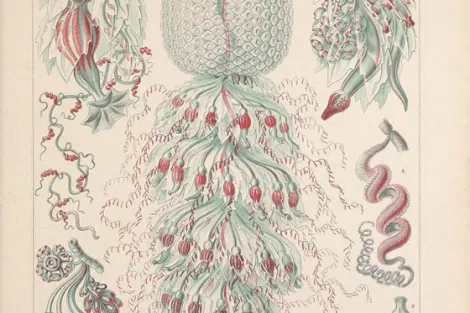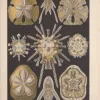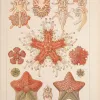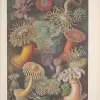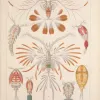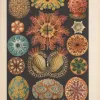The siphonophores are an order of marine animals in the phylum Cnidaria (the same phylum containing jellyfish). Although they superficially resemble jellyfish, each siphonophore specimen is actually a colony of many genetically identical individuals called zooids. Each zooid is specialized to serve a particular function within the colony—so much so that most cannot survive alone. The infamous and venomous Portuguese man o' war is a member of this order. Certain siphonophore species can emit light. A species in the Erenna genus found off the coast of Monterey, California has stinging cells that glow red, probably to attract the small fish upon which it preys. This species is only the second life form known to produce a red light, the first being the scaleless dragonfish (Chirostomias pliopterus).
Prints from Ernst Haeckel
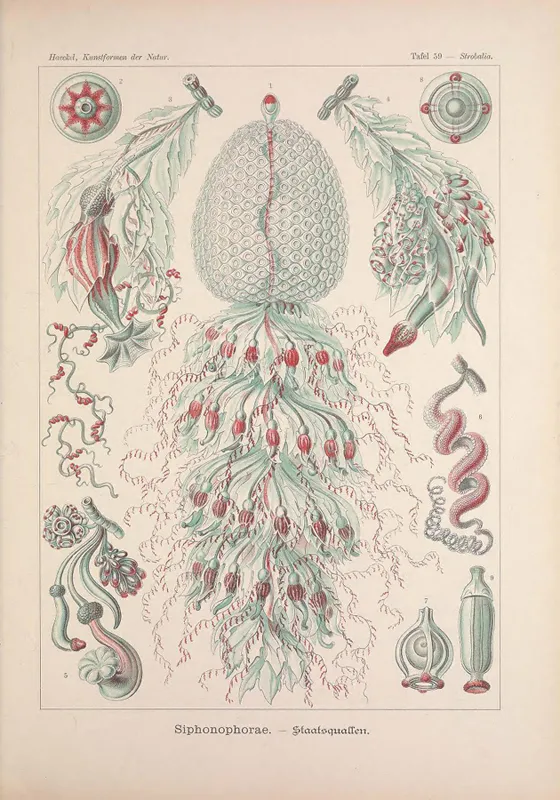
Siphonophores
Credit: Ernst Haeckel, Kunstformen der Natur / Biodiversity Heritage Library
Sea Urchins
Credit: Ernst Haeckel, Kunstformen der Natur / Biodiversity Heritage LibraryHistorically, sea urchins were known as sea hedgehogs due to their superficial resemblance to the spiny mammalian species. “Urchin” is, in fact, a Middle English term for hedgehog. Sand dollars (like those pictured in this set of illustrations) are flattened, burrowing sea urchins. Dead, sunlight-bleached specimens resemble silver coins, hence their common name. These figures portray a sand dollar’s lifecycle from larva to adult. The center specimen, at two-months old, is only a millimeter long in life, and yet Haeckel managed to portray it in extreme detail. These details were made possible thanks to 19th century advances in the microscope, particularly the invention of the apochromatic lens system, which allows two wavelengths to be brought to the same focus.
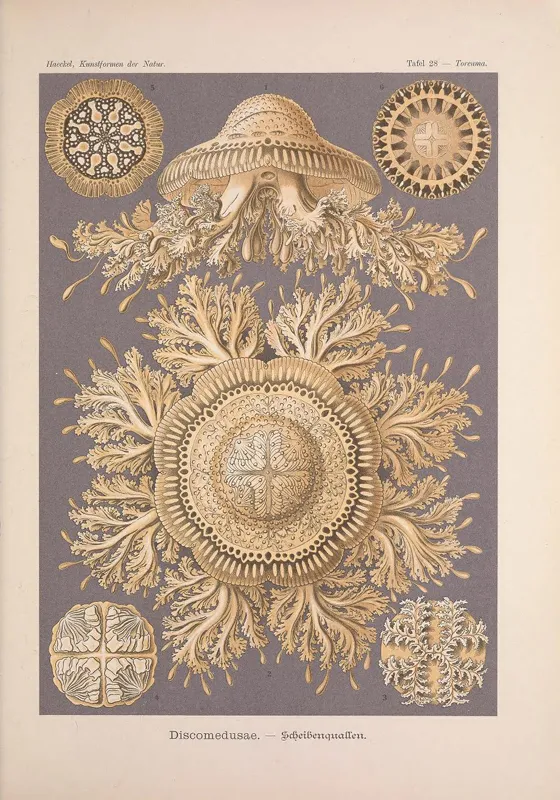
Rhizostome Jellyfish
Credit: Ernst Haeckel, Kunstformen der Natur / Biodiversity Heritage LibraryHaeckel was inspired by nature to create not just stunning illustrations but decorative pieces for home interiors as well. Haeckel discovered a species of Rhizostomae jellyfish in Bellagemma, Ceylon, in December 1881. He was so impressed with the form that he used it as a model for ceiling decorations in his Villa Medusa home in Jena. Today, all jellyfish species fished on a commercial basis for human consumption are from the Rhizostomae order. Typically dried and/or salted before eating, China is the first documented country to eat jellyfish, with the practice dating back to at least 300 CE.
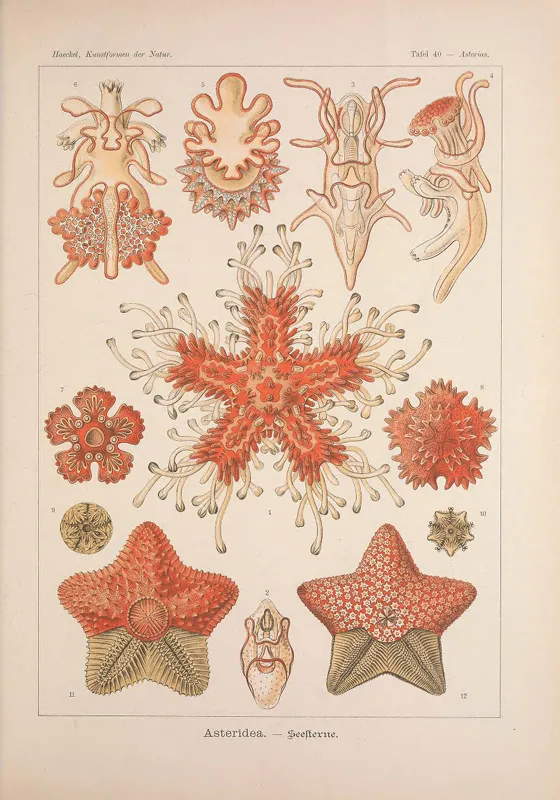
Starfish
Credit: Ernst Haeckel, Kunstformen der Natur / Biodiversity Heritage LibraryStarfish—marine invertebrates of the phylum Echinodermata—are famous for their ability to shed limbs as a means of defense and then regenerate the sacrificed part. Ancient creatures, the fossil record for starfish extends back to around 450 million years ago. Figures 1-8 of this plate represent various larval and the adult stages of Asterias rubens, the most common starfish in the northeast Atlantic. Today, some starfish species are sadly stricken with a disease caused by a newly-identified virus that literally causes them to melt into a pile of slime.

Nudibranchs
Credit: Ernst Haeckel, Kunstformen der Natur / Biodiversity Heritage LibraryNudibranchs (often casually called sea slugs) are soft-bodied, marine snails that have lost all trace of an external shell. The name “nudibranch” translates from the Latin as “naked gills.” Consisting of about 3,000 species, some have developed impressive defenses, including the ability to synthesize toxic compounds (such as sulfuric acid) or the ability to "hijack" and repurpose the stinging cells of the cnidarians (jellyfish, anemones, and corals) that some of them eat. Poisonous nudbranchs are often very brightly colored to warn potential predators that they are not good to eat.

Sea Anemones
Credit: Ernst Haeckel, Kunstformen der Natur / Biodiversity Heritage LibrarySea anemones are members of the phylum Cnidaria, and as such are related to corals and jellyfish. Unlike jellyfish, however, anemones (and other anthozoans like corals) lack the free-swimming medusa stage. As sessile polyps, sea anemones have column-like bodies ending in an oral disk surrounded by tentacles that contain many stinging cells (cnidocytes) used for defense and capturing prey. The iconic clownfish are immune to these stinging cells’ toxin, however, and take refuge from their predators amidst sea anemones’ tentacles.

Copepods
Credit: Ernst Haeckel, Kunstformen der Natur / Biodiversity Heritage LibraryCopepods are aquatic crustaceans found in every marine habitat, from surface waters to the deep sea. With over 13,000 described species, they are among the most abundant of all multicellular animals. About half are parasites; the rest are free-living and make up much of the ocean's zooplankton. Figures 6 and 7 are particularly intriguing, as they portray various ways that female copepods carry fertilized eggs in egg sacs attached to their bodies.
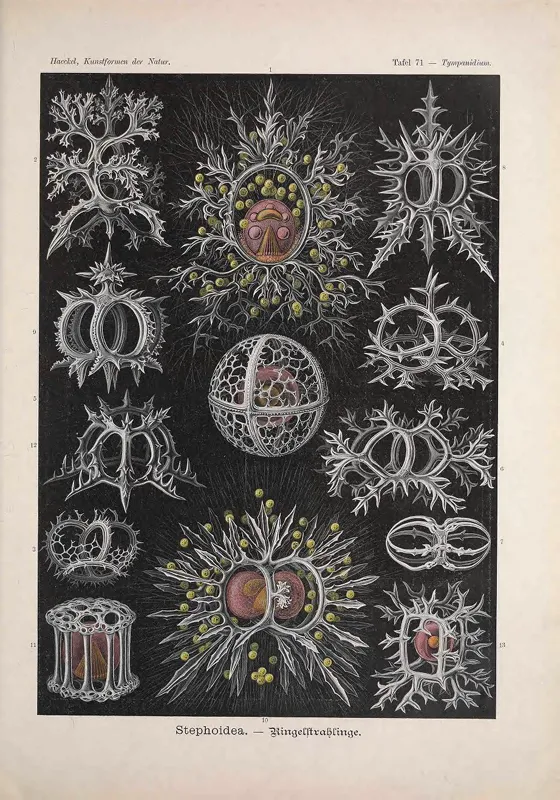
Radiolarians
Credit: Ernst Haeckel, Kunstformen der Natur / Biodiversity Heritage LibraryOf all of the species Haeckel described, he is most famous for his illustrations of radiolarians. Planktonic, unicellular marine eukaryotes, radiolarians are found in all of the world’s oceans. The multiple body compartments of a radiolarian are surrounded by an elaborate mineral skeleton called the test, which exhibits the exquisite designs that so captivated Haeckel. Haeckel first encountered these beauties while at Messina in Sicily, and it was this experience that prompted him to pursue doctorate studies in zoology. Haeckel helped popularize these animals with the public through his 1862 monograph Die Radiolarien, his 1887 report as part of the H.M.S. Challenger expedition, and his illustrations in Kunstformen der Natur.
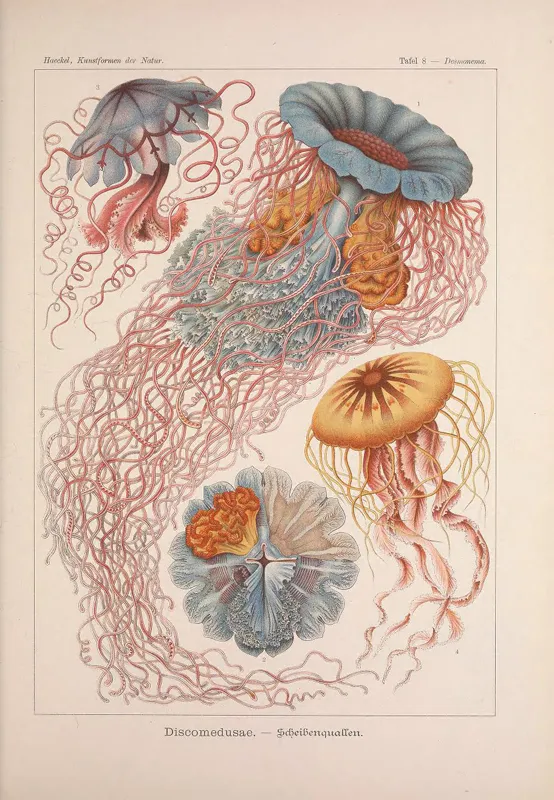
Semaeostome Jellyfish
Credit: Ernst Haeckel, Kunstformen der Natur / Biodiversity Heritage LibraryThe Semaeostomes (the name translates to “flag mouths”) are an order of jellyfish exhibiting four long, frilly oral arms. Figures 1 and 2 in this set of illustrations portray a species Haeckel named Desmonema annasethe after his wife, Anna Sethe. Anna died suddenly of an “undetermined fever” after the couple had been married only 18 months. A heartbroken Haeckel wrote the following tribute to his wife in reference to another species he named after her:
"Mitrocoma annae belong to the most charming of all the Medusae. It was first observed by me in April 1864 in the Bay of Villafranca near Nice. Its tentacles hung like blonde hair ornaments of a princess. I named this species as a memorial to my unforgettable true wife, Anna Sethe. If I have succeeded, during my earthly pilgrimage in accomplishing something for natural science and humanity, I owe the greatest part to the ennobling influence of this gifted wife."
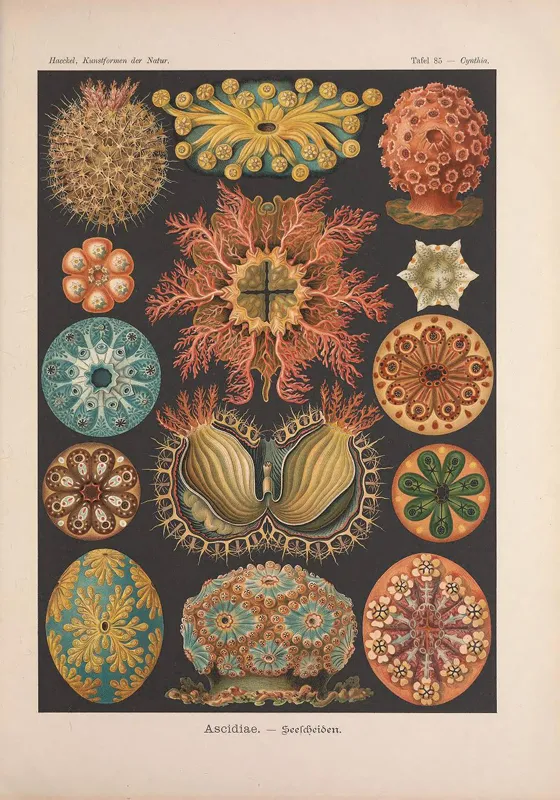
Sea Squirts
Credit: Ernst Haeckel, Kunstformen der Natur / Biodiversity Heritage LibrarySea squirts, or ascidians, are a diverse class of marine invertebrates representing about 2,300 species. As adults they are sessile animals (attached to the bottom) that feed by filtering food from water, sea squirts exhibit three main types: solitary, social, and compound. Social sea squirts attach at their bases to form clumped communities of genetically identical clones. Compound sea squirts (like the siphonophores) form colonies by budding off many small, genetically identical and interconnected individuals called zooids. Unlike the adults, the larvae of sea squirts can swim and have a structure that represents an early stage in the evolution of the backbone of vertebrates, which is why they are in the same phylum, Chordata, that we are in.


